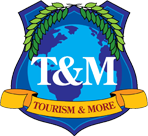When travel experts travel
June 2002
One of the great parts of working in the travel industry is the chance to travel. While travel is still a great experience, many of us who travel a great deal have also come to realize that air travel especially is a lot less enjoyable then it used to be. Not only are the lines often longer, the food less plentiful (if it exists at all) and the service offered often a challenge, but also issues of safety and security abound. It is imperative that travel professionals travel, not only to have a better sense of their industry but also to understand the joys and tribulations of our customers. Traveling a lot does not mean however that we should sacrifice our personal security, so this month Tidbits offers you some suggestions on airport safety and what you can do to make your flight safer if not more enjoyable.
At Airports
There is no doubt that when there is an air-mishap, it makes the news. In fact although air travel is statistically the safest way to fly, when an accident or incident occurs people notice it. In statistics this is called a low risk/high consequences event. In other words, although the risk of an airplane disaster is low, the consequences are very great. The US government is making great strides in improving the safety of air travel. None the less, the ultimate person who must be responsible for his/her safety and security is you, the traveler. Here are some hints and ideas to make your travel as safe as possible.
- Airport Parking:
- Note down where you car is parked. It is best to park under a light and as close to a shuttle bus route as possible.
- Before you exit your car, notice who is in your proximity. Then:
- Jot down the space and place before exiting the car,
- Turn your cell phone on prior to exiting the car and put it in a place, such as a pocket, which is easily found. Do not leave the phone in a purse or briefcase. If someone were to bother you in a parking lot you would not have time to find a cell phone in a purse or handbag. Have the phone set to an emergency number.
- Keep baggage close to you. If you travel lightly (and you should) there is no need to put baggage in the trunk of a car.
- If you are parking indoors and returning late, find out if the indoor lot is monitored or if there is a security escort policy in place.
- At the terminal:
- From a crime and security standpoint the most dangerous place to be is in a check-in line. If you have confirmation of a ticket, go through security as quickly as possible and check-in at the gate. Remember that outside of the cleared security parts of an airport you are most vulnerable to attack and robberies. This is the area of the airport to pass-through as soon as you can.
- At the Gate:
- You should have less risk once you have past through security. Nevertheless there are risks. Here are some dos and don’ts.
- Watch and report unattended packages.
- Never take your eye off your luggage. It takes under a minute for someone to walk off with your bag and then simply to fade into the crowd.
- Keep wallets in front pocket of pants and not in front pockets of jacket. Often men when traveling leave their wallets in their jacket’s breast pocket, then go to use the men’s room and while in a stall someone steals their wallet. This over stall-door technique is often supplemented by the under stall wallet snatch. This technique is used against men who keep their wallet in their back pocket.
- Carry your bags onto the plane rather than checking them. Many a robbery takes place in the “behind the scenes” parts of airports. When you see it, you know you have it.
- Try to chat with as few people as possible. Never state what you do or give away your business card. You have no way of knowing who the person is to whom you are talking or what he/she does.
- On the Aircraft:
- Be alert. It was an alert passenger who discovered the shoe bomber and kept the plane from going down over the Atlantic.
- Inside seats, by the window, are less convenient but safer. Aisle seating is more convenient and often has a bit more legroom, but also increases the probability of being hurt in case of a terrorist attack.
- If you worry about someone putting something into the food that you consume on an airplane (or simply cannot stand the taste) bring your own food from home or from a restaurant.
- Never leave a purse/handbag on your seat while at the rest room.
- Do not count money, documents etc while in public, including on an airplane.
- If the situation calls for it, break the rules. The people who made cell phone calls from the Sept 11th, 2001 flight were heroes and may have saved many other people’s lives.



